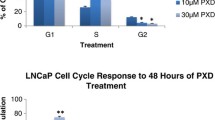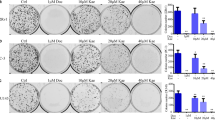Abstract
Prostate cancer is the major health problem and the leading cause of male cancer death. Quercetin is a novel antitumor and antioxidant, whose molecular mechanism involved in cell cycle arrest in androgen independent prostate cancer cells remains unclear. In this study, we investigated the effects of quercetin on proliferation and cell cycle arrest by modulation of Cdc2/Cdk-1 protein in prostate cancer cells (PC-3). PC- 3 cells are human androgen independent cancer cells and were cultured with quercetin at concentrations of 50 and 100 μM for 24 h. Cell proliferation, apoptosis and cell cycle distribution were analyzed. Expression of Cdc2/Cdk-1, cyclin B1, cyclin A, p21/Cip1, pRb, pRb2/p130, Bcl-2, Bcl-XL, Bax and caspase-3 proteins were studied with western blot analysis. Addition of quercetin led to substantial decrease in the expression of Cdc2/Cdk-1, cyclin B1 and phosphorlyated pRb and increase in p21. Flowcytometric analysis showed that quercetin blocks G2-M transition, with significant induction of apoptosis. Apoptosis markers like Bcl-2 and Bcl-XL were significantly decreased and Bax and caspase-3 were increased. From this study, it was concluded that quercetin inhibits prostate cancer cell proliferation by altering the expression of cell cycle regulators and apoptotic proteins.






Similar content being viewed by others
References
Agarwal R (2000) Cell signaling and regulators of cell cycle as molecular targets for prostate cancer prevention by dietary agents. Biochem Pharmacol 60:1051–1059
Aquilina JW, Lipsky JJ, Bostwick DG (1999) Androgen deprivation as strategy for prostate cancer chemoprevention. J Nutr Cancer Inst 89:689–696
Balabhadrapathruni S, Thomas TJ, Yurkow EJ, Amenta PS, Thomas T (2000) Effects of genistein and structurally related phytoestrogens on cell cycle kinetics and apoptosis in MDA-MB-468 human breast cancer cells. Oncol Rep 7:3–12
Buchkovich K, Duffy LA, Harlow E (1989) The Retinoblastoma protein is phosphorlyated during specific phases of the cell cycle. Cell 58:1097–1105
Casagrande F, Darbon JM (2001) Effects of structurally related flavonoids on cell cycle progression of human melanoma cells: regulation of cyclin-dependent kinases CDK2 and CDK1. Biochem Pharmacol 61:1205–1215
Catz SD, Johnson JL (2003) Bcl-2 in prostate cancer; a minireview. Apoptosis 8:29–37
Choi JA, Kim JY, Lee JY, Kang CM, Kwon HJ, Yoo YD, Kim TW, Lee YS, Lee SJ (2001) Induction of cell cycle arrest and apoptosis in human breast cancer cells by quercetin. Int J Oncol 19:837–844
Csokay B, Prajda N, Weber G, Olah E (1997) Molecular mechanisms in the antiproliferative action of quercetin. Life Sci 60:2157–2163
Dyson N (1998) The regulation of E2F by pRB-family proteins. Genes Dev 12:2245–2262
Ewen ME (1994) The cell cycle and the retinoblastoma protein family. Cancer Metastasis Rev 13:45–66
Ferriola PC, Cody V, Middleton E Jr (1989) Protein-kinase C inhibition by plant flavonoids. Kinetic mechanisms and structure-activity relationship. Biochem Pharmacol 38:1617–1624
Gali-Muhtasib H, Bakkar N (2002) Modulating cell cycle: current applications and prospects for future drug development. Curr Can Drug Targets 2:309–336
Gioeli D, Mandell JW, Petroni GR, Frierson Jr HF, Weber MJ (1999) Activation of mitogen-activated protein kinase associated with prostate cancer progression. Cancer Res 59:279–284
Grana X, Reddy P (1999) Cell cycle control in mammalian cells: role of cyclins, cyclin-dependent kinase (CDKs), growth-suppressor genes, cyclin-dependent kinase inhibitors (CDKIs). Oncogene 11:211–219
Howard CM, Claudio PP, Luca AD, Stiegler P, Jori FP, Safdar NM, Caputi M, Khalili K, Giordano A (2000) Inducible pRb/p130 expression and growth-suppressive mechanisms: evidence of pRb130, p27kip1, and cyclin E negative feedback regulatory loop. Cancer Res 60:2737–2744
Knowles LM, Zigrossi DA, Tauber RA, Hightower C, Milner JA (2000) Flavonoids suppress androgen-independent human prostate tumor proliferation. Nutr Can 38:116–122
Lees JA, Buchkovich KJ, Marshak DR, Anderson CW, Harlow E (1991) The retinoblastoma protein is phosphorylated on multiple sites by human cdc2. EMBO J 10:4279–4290
Li X, Marami M, Yu J, Nan B, Roth JA, Kagawa S, Fang B, Dennerr L, Marcelli M (2001) Adenovirus-mediated Bax overexpression for the induction of therapeutic apoptosis in prostate cancer. Cancer Res 61:186–191
Lin BT-Y, Gruenwald S, Morla AO, Lee W-H, Wang JYJ (1991) Retinoblastoma cancer suppressor gene product is a substrate of the cell cycle regulator cdc2 kinase. EMBO J 10:857–864
Lowry OH, Rosebrough NJ, Farr AL, Randall RJ (1951) Protein measurement with the Folin-phenol reagent. J Biol Chem 193:265–270
Malumbres M, Barbacid M (2001) To cycle or not to cycle: a critical decision in cancer. Nature Rev Cancer 1:222–231
Martin JL, Pattison SL (2000) Insulin-like growth factor binding protein-3 is regulated by dihydrotestosterone and stimulates deoxyribonucleic acid synthesis and cell proliferation in LNCaP prostate carcinoma cell. Endocrinology 141:2401–2409
Mittnacht S (1998) Control of pRB phosphorylation. Curr Opin Genet Dev 8:21–27
Morgan DO (1995) Principles of CDK regulation. Nature 374:131–134
Nguyen TT, Tran E, Nguyen TH, Do PT, Huynh TH, Huynh H (2004) The role of activated MEK-ERK pathway in quercetin-induced growth inhibition and apoptosis in A549 lung cancer cells. Carcinogenesis 25:647–659
Paggi MG, Baldi A, Bonetto F, Giordano A (1996) Retinoblastoma protein family in cell cycle and cancer: a review. J Cell Biochem 62:418–430
Paggi MG, Felson A, Giordano A (2003) Growth control by the retinoblastoma gene family. In: El Deiry WS (ed) Tumor suppressor genes (Vol 1). Humana Press, New Jersey, pp 3–19
Pavletich NP (1999) Mechanisms of cyclin-dependent kinase regulation: structures of cdks, their cyclin activators and Cip and INK4 inhibitors. J Mol Biol 287:821–828
Quinn M, Babb P (2002) Patterns and trends in prostate cancer incidence, survival, prevalence and mortality. Part I. International comparisons. BJU Int 90:162–173
Srivastava RK, Srivastava AR, Korsmeyers J, Nesterva M, Cho-chung YS, Longo DL (1998) Involvement of microtubules in the regulation of Bcl-2 phosphorylation and apoptosis through cyclic AMP-dependent kinase. Mol Cell Biol 18:3509–3517
Taraphdar AK, Roy M, Bhattacharya RK (2001) Natural products as inducers of apoptosis: implication for cancer therapy and prevention. Curr Sci 80:1387–1396
Vijayababu MR, Kanagaraj P, Arunkumar A, Srinivasan N, Michael Aruldhas M, Arunakaran J (2004) Effects of quercetin on IGF system components in PC-3 cells. In: XXII symposium of the society for reproductive biology and comparative endocrinology (SRBCE), Chennai, pp 30–31
Wang S, DeGroff VL, Clinton SK (2003) Tomato and soy polyphenols reduce insulin-like growth factor-I-stimulated rat prostate cancer cell proliferation and apoptotic resistance in vitro via inhibition of intracellular signaling pathways involving tyrosine kinase. J Nutr 133:2367–2376
Xiong Y, Hannon GJ, Zhang H, Casso D, Kobayashi R, Beach D (1993) p21 is a universal inhibitor of cyclin kinases. Nature 366:701–704
Yuan H, Pan Y, Young CY (2004) Overexpression of c-Jun induced by quercetin and resverol inhibits the expression and function of the androgen receptor in human prostate cancer cells. Cancer Lett 213(2):155–63
Acknowledgements
We would like to thank Dr. Ion V. Deaciuc (University of Louisville, Kentucky, USA) for providing Bcl-2 and Bax antibodies and Prof. Franca Esposito (Universita’ di Napoli, Italy) for providing pRb antibody. We also thank Prof. Dhinakarraj, Animal Biotechnology, TANUVAS, Chennai, India for providing flowcytometry facility.
Author information
Authors and Affiliations
Corresponding author
Additional information
This work was supported by grants from University Grants Commission (UGC award No. F.3.41 / 2002 (SR-II) dated 14-03-2002) to Dr. J. Arunakaran.
Rights and permissions
About this article
Cite this article
Vijayababu, M., Kanagaraj, P., Arunkumar, A. et al. Quercetin-induced growth inhibition and cell death in prostatic carcinoma cells (PC-3) are associated with increase in p21 and hypophosphorylated retinoblastoma proteins expression. J Cancer Res Clin Oncol 131, 765–771 (2005). https://doi.org/10.1007/s00432-005-0005-4
Received:
Accepted:
Published:
Issue Date:
DOI: https://doi.org/10.1007/s00432-005-0005-4




